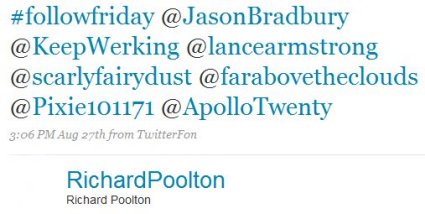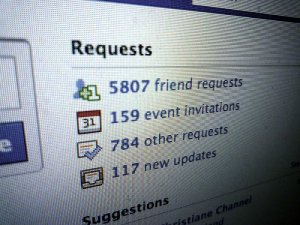The more options we have to communicate with each other, the more ways we can annoy each other. For some reason when people do it in mass they think it’s OK. Here are some common communications practices that are irritating and must end in 2011.
1. Holding meetings to solve all problems
I’ve worked with far too many organizations where the solution to every problem is “Let’s have a meeting.” Sometimes it’s qualified with “Let’s have a kick off meeting” (Read “No more ‘What are we going to do in social media’ meetings”). Not every problem requires a meeting as a solution. In fact, a meeting often creates more problems.
 Instead of trying to intelligently solve the problem, the organizer will use the meeting as a crutch to come up with a solution. It’s a lazy move. It’s the equivalent of saying, “I can’t figure out who I should ask to solve this problem, so I’m going to drag all of you into a meeting to figure it out for me.”
Instead of trying to intelligently solve the problem, the organizer will use the meeting as a crutch to come up with a solution. It’s a lazy move. It’s the equivalent of saying, “I can’t figure out who I should ask to solve this problem, so I’m going to drag all of you into a meeting to figure it out for me.”
Let me give you the most egregious example of this. I was working at an event and all I needed was to confirm some technical specs with the event manager. The person who had the contact of the event manager immediately wanted to a hold a meeting. Thus began the series of “When are you available?” emails. I said that a meeting isn’t necessary, I just need answers to these questions. I had typed them out in an email. An email or phone call to the contact will solve everything.
2. Acting as an email liaison
With a couple of caveats, this is one of the most pointless activities. It’s often done to protect a relationship. In the situation I described above, that’s exactly what happened. Instead of just giving me the event person’s contact information, my contact wanted to act as a liaison to the event manager. Thus began a discussion of me literally spelling out all my specifics to someone who had no idea what I was talking about. Finally, I got the contact person’s email.
There are some cases where an email liaison can actually be advantageous. PR people and executive assistants are awesome at it in that they save you time by managing all the email correspondence. If you don’t have one of those two positions where your role as “email liaison” is actually simplifying a situation, stop doing it.
3. #FollowFriday
 Luckily, this once very popular Twitter recommendation process, is dying its own rapid death. It’s the process by which tweeters list other users with no context and then dictate that their followers follow them (see “Can we all make #followfriday suck less?”). Not in any other situation would we behave like this. If someone came up to you and only said, “Steve, Robert, Katie, John. Pay attention to them,” you’d think that person was an a-hole.
Luckily, this once very popular Twitter recommendation process, is dying its own rapid death. It’s the process by which tweeters list other users with no context and then dictate that their followers follow them (see “Can we all make #followfriday suck less?”). Not in any other situation would we behave like this. If someone came up to you and only said, “Steve, Robert, Katie, John. Pay attention to them,” you’d think that person was an a-hole.
Much of the #FollowFriday behavior has been replaced with far more valuable and relevant Twitter lists.
Here’s me on Cranky Geeks last year complaining about #FollowFriday.
4. Keeping people on cc lists when they’re no longer part of the conversation
I often make introductions. In response, I will usually receive two emails from the two parties I introduced thanking me for the introduction. And then that’s it. That’s what it should be.
In many cases that’s not what happens. Often I’m left on the cc list as the two parties I introduced are making plans. After deleting a few of these emails I eventually have to step in with, “Hey guys, can you take me off this thread.” I come off as being an a-hole when in reality, they’re the insensitive ones for keeping me on the list. And that’s not how any of us want to feel because we all like each other. Heck, I introduced them in the first place.
5. Cc-ing everyone to tell them to stop cc-ing everyone
Unless you’re the CEO disciplining your staff for incorrect behavior, this move has “schmuck” written all over it. The most egregious case of this is when someone sends out a mass mail and accidentally puts all the addresses in the cc field when they should have been in the bcc field (Read “Social media ‘gurus’ and bloggers are egotistical jerks”). Inevitably, multiple people on the distribution list pull their “I’m holier then thou” attitude and explain how wrong it was for the person to cc everyone, and that its wrongness is second only to Bernie Madoff swindling Holocaust survivors. Then in an effort to shut those people up, other supposedly “more sane” recipients cc everyone to tell them to stop cc-ing everyone.
6. CYA (Cover Your Ass) cc’s
This is one of the most common practices that is detrimental to an organization’s productivity. People claim the reason they cc someone on an email is to “keep them in the loop.” But in actuality these CYA cc’s are insanely selfish. The person is not looking to benefit the organization as a whole but rather have a digital paper trail to cover their own job within the organization. Each cc wastes the recipient’s time and thus the productivity of the whole organization. Way to go “team player.”
If you want to create a paper trail of your work, without bothering people in email, use Yammer, wikis, and other Enterprise 2.0 tools.
7. Pictures of your meals on Facebook
 WHY would I want to see that? What exact reaction are you looking to get out of me for this? I believe there are some people who actually enjoy seeing those photos, but I’ve never met them.
WHY would I want to see that? What exact reaction are you looking to get out of me for this? I believe there are some people who actually enjoy seeing those photos, but I’ve never met them.
There are “food porn” blogs and Facebook groups. Please post your photos there where people really care.
8. Using email as IM
If an email thread is ten messages long, took place in less than an hour, and each message is no longer than a sentence, then move it to an instant messenger. Both parties are to blame here. Each email message requires multiple clicks to open, read, respond, send, and delete. IM is designed for rapid fire communications. Use it.
9. Posting all your photos on Facebook without editing them
 I’m trying to fully understand what goes on in the mind of a person who doesn’t edit out or fix their blurry, upside down, and duplicate photos. After a lot of deliberating, I’ve narrowed it down to two options:
I’m trying to fully understand what goes on in the mind of a person who doesn’t edit out or fix their blurry, upside down, and duplicate photos. After a lot of deliberating, I’ve narrowed it down to two options:
- I’m so fabulous and such a fabulous photographer that everyone will want to see all of my photos, no matter what they look like.
- I’m so crazy busy that I don’t have time to edit these wonderful pictures of me and all my friends. I’ll let my Facebook friends pick which ones are their favorites.
Either way, you’re a jackass. Instead of just wasting your time, you’ve just wasted everyone’s time. When I eventually run into these people in person my thoughts immediately go to “Oh you’re the self-centered putz that doesn’t edit your photos.” From here on in you will only be known for that. Congrats, that fifteen minutes you chose not to edit your photos just did wonderful damage to your personal brand.
10. Making a Facebook friend request and then not responding to personal messages
Since Facebook started recommending people for us to be friends with, we’ve all begun receiving a lot more friend requests. I keep rather copious notes on who I’ve met, but sometimes I will forget, and more often people who I don’t know will make a Facebook friend request. That’s perfectly fine, but I only request that you actually respond to a personal message if you want me to accept your friend request. Stunningly, more than 25 percent of the friend requesters refuse to respond to personal messages (Read “One quarter of people who friend me on Facebook don’t respond to personal messages”).
 Attached to this issue is Facebook’s privacy setting of only accepting personal messages from people you’ve friended. This backfires on you when you send a friend request. The person can’t contact you asking about the friend request. If you turn off your email to outsiders, then I can’t contact you to make an initial personal contact, and I have no choice but to delete your friend request.
Attached to this issue is Facebook’s privacy setting of only accepting personal messages from people you’ve friended. This backfires on you when you send a friend request. The person can’t contact you asking about the friend request. If you turn off your email to outsiders, then I can’t contact you to make an initial personal contact, and I have no choice but to delete your friend request.
11. Mass “Would you endorse me?” recommendation requests on LinkedIn
Nothing screams “I’m the world’s laziest networker” than this move. LinkedIn should simply turn this feature off (you can send out up to 200 mass recommendation requests at a time).
12. Collecting business cards at a networking event, and not following up
This is sadly an extremely common behavior. I would say less than 10 percent of the people I hand my business card to actually follow up with me. Why are you collecting business cards and not doing anything with them?
13. You meet someone in person, they follow up, and you don’t respond
 I try to make it a point to follow up with everyone I collect a business card from. While it may be bad not to follow up with someone that you collected a business card from in person, it’s now offensive to not respond to a personal email. You just met in person! It’s reprehensible.
I try to make it a point to follow up with everyone I collect a business card from. While it may be bad not to follow up with someone that you collected a business card from in person, it’s now offensive to not respond to a personal email. You just met in person! It’s reprehensible.
When someone doesn’t respond, it just lowers my opinion of them. And then inevitably I’ll run into that person again and the meeting is horribly awkward, for them, not me. Conversely, I’ve had people not respond and when they do see me they act overly friendly to the point it’s creepy and obvious that they’re compensating for their obvious extended non-response.
14. Getting angry over email
 You’re allowed to do this once, and that’s it. After that, grow up. Next time you see an email conversation turn south, pick up the phone. I don’t care how much of an idiot you think the other person is, if you let a pissing match continue via email, you’re the idiot.
You’re allowed to do this once, and that’s it. After that, grow up. Next time you see an email conversation turn south, pick up the phone. I don’t care how much of an idiot you think the other person is, if you let a pissing match continue via email, you’re the idiot.
If you don’t do it soon in the exchange, then it gets awkward to determine who’s going to end it. You’re eventually going to run into each other in person, and if you didn’t pick up the phone to end it, it’s going to be a wonderfully uncomfortable meeting. Enjoy!
15. Auto DMs after someone follows you on Twitter
I would love it if Twitter would just turn this feature off so no one would ever do it again. It is extremely disingenuous. If it’s true when you say “Thanks for the follow” in your auto DM, then follow me back and @reply something I tweeted. Otherwise, it usually results in an instant “unfollow.”
That’s exactly what happened with the message below. Auto DM, no follow back, so I unfollowed.

16. @Reply multiple people with the same request
It’s just another form of spam, but some idiots think @replying the same message repeatedly to multiple Twitter users is a good form of marketing. Not at all. The moment I get one of those emails I go take a look at the user’s thread to confirm they’re a spammer.
Did I get the list right? Anything you disagree with? Would like to add? I’m sure there are plenty more that I haven’t thought of.
Creative Commons photo credits to kazamatsuri (his photo is the blurry one and no I don’t think he’s a jackass. Actually, I thank him for putting that photo on Flickr for me to use as an example in this post. Thanks Kaza!), Sandy Austin (same for your food photo Sandy. Thanks!), and kaysha.
Stock photos courtesy of Shutterstock.




